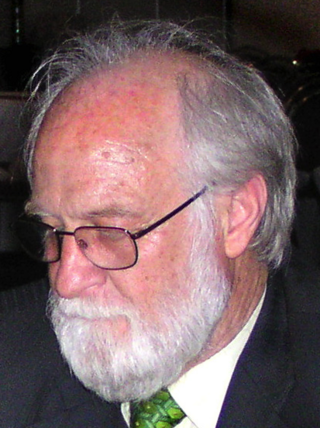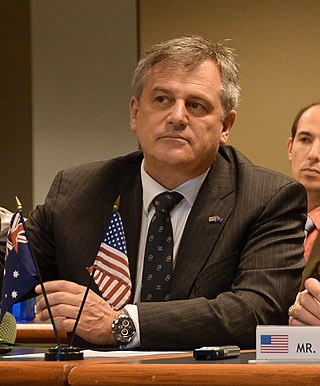Related Research Articles
Nancy Fannie Millis was an Australian microbiologist and Emeritus Professor who introduced fermentation technologies to Australia, and created the first applied microbiology course taught in an Australian university.
In chemistry, initiation is a chemical reaction that triggers one or more secondary reactions. Initiation creates a reactive centre on a molecule which produces a chain reaction. The reactive centre generated by initiation is usually a radical, but can also be cations or anions. Once the reaction is initiated, the species goes through propagation where the reactive species reacts with stable molecules, producing stable species and reactive species. This process can produce very long chains of molecules called polymers, which are the building blocks for many materials. After propagation, the reaction is then terminated. There are different types of initiation, with the two main ways being thermal initiation and photo-initiation (light).

Reversible addition−fragmentation chain-transfer or RAFT polymerization is one of several kinds of reversible-deactivation radical polymerization. It makes use of a chain-transfer agent (CTA) in the form of a thiocarbonylthio compound to afford control over the generated molecular weight and polydispersity during a free-radical polymerization. Discovered at the Commonwealth Scientific and Industrial Research Organisation (CSIRO) of Australia in 1998, RAFT polymerization is one of several living or controlled radical polymerization techniques, others being atom transfer radical polymerization (ATRP) and nitroxide-mediated polymerization (NMP), etc. RAFT polymerization uses thiocarbonylthio compounds, such as dithioesters, thiocarbamates, and xanthates, to mediate the polymerization via a reversible chain-transfer process. As with other controlled radical polymerization techniques, RAFT polymerizations can be performed under conditions that favor low dispersity and a pre-chosen molecular weight. RAFT polymerization can be used to design polymers of complex architectures, such as linear block copolymers, comb-like, star, brush polymers, dendrimers and cross-linked networks.

David Morritz de Kretser, FAA FTSE FAHMS is an Australian medical researcher who served as the 27th Governor of Victoria, from 2006 to 2011.
Adrienne Elizabeth Clarke is Professor Emeritus of Botany at the University of Melbourne, where she ran the Plant Cell Biology Research Centre from 1982–1999. She is a former chairman of the Commonwealth Scientific and Industrial Research Organisation, former Lieutenant Governor of Victoria (1997–2000) and former Chancellor of La Trobe University (2011–2017).
The Australian Academy of Technology and Engineering (ATSE) is a learned academy that helps Australians understand and use technology to solve complex problems. It was founded in 1975 as one of Australia's then four learned academies. Its original name was the 'Australian Academy of Technological Sciences', but in 1987 the name was lengthened to include Engineering, as 'Australian Academy of Technological Sciences and Engineering'. In 2015, the Academy adopted a new business name, the 'Australian Academy of Technology and Engineering', reserving the Australian Academy of Technological Sciences and Engineering as its company name.
William James Peacock, is an Australian molecular biologist who was Chief Scientist of Australia (2006–2008), President of the Australian Academy of Science (2002–2006) and Chief of CSIRO Plant Industry (1978–2003).

Ronald David Ekers FRS FAA is an Australian radio astronomer. His fields of specialty include the study of active galactic nuclei, cosmology, and radio astronomy techniques.

Alexander ‘Alex’ Zelinsky, is an Australian computer scientist, systems engineer and roboticist. His career spans innovation, science and technology, research and development, commercial start-ups and education. Professor Zelinsky is Vice-Chancellor and President of the University of Newcastle joining the university in November 2018. He was the Chief Defence Scientist of Australia from March 2012 until November 2018. As Chief Defence Scientist he led Defence Science and Technology for Australia's Department of Defence.

Andrew Bruce Holmes is an Australian and British senior research chemist and professor at the Bio21 Institute, Melbourne, Australia, and the past President of the Australian Academy of Science. His research interests lie in the synthesis of biologically-active natural products and optoelectronic polymers.

Tanya Mary Monro FOSA FAIP GAICD is an Australian physicist known for her work in photonics. She has been Australia's Chief Defence Scientist since 8 March 2019. Prior to that she was the Deputy Vice Chancellor, Research and Innovation (DVCR&I) at the University of South Australia. She was awarded the ARC Georgina Sweet Australian Laureate Fellowship in 2013. She was the inaugural chair of photonics, the inaugural director of the ARC Centre of Excellence for Nanoscale Biophotonics and the inaugural director of the Institute for Photonics & Advanced Sensing (IPAS), and the inaugural director of the Centre of Expertise in Photonics (CoEP) within the School of Chemistry and Physics at the University of Adelaide. Monro has remained an adjunct professor of physics at the University of Adelaide following her departure from the institution.
Elizabeth Salisbury Dennis is an Australian scientist working mainly in the area of plant molecular biology. She is currently a chief scientist at the plant division of CSIRO Canberra. She was elected a Fellow of the Australian Academy of Technological Sciences and Engineering (FTSE) in 1987, and the Australian Academy of Science in 1995. She jointly received the inaugural Prime Minister's Science Prize together with Professor Jim Peacock in 2000 for her outstanding achievements in science and technology.

Graeme John Jameson is an engineer, professor and Director of the Centre for Multiphase Processes at the University of Newcastle, Australia, in New South Wales, Australia. He is notable for being the inventor of the Jameson Cell mineral separation device, which he devised in the 1980s. The Jameson Cell uses bubbles to separate super fine particles during mineral processing. It is based on the froth flotation mineral separation process, first invented in 1905.

David Henry Solomon is an Australian polymer chemist. He is best known for his work in developing Living Radical Polymerization techniques, and polymer banknotes.
Professor Helene Denise Marsh is an Australian scientist who has provided research in the field of Environmental Science, more specifically Zoology and Ecology. The focal point of her research has been the biology of dugongs, with particular foci in the areas of population ecology, history, reproduction, diet, and movements. She is the Dean of Graduate Research Studies and the Professor of Environmental Science at James Cook University in Queensland, Australia, and also a Distinguished Professor in the College of Marine and Environmental Science. Marsh is also a program leader for the Marine and Tropical Research Science Facility. In 2015 she was elected a Fellow of both the Australian Academy of Science (FAA), and the Australian Academy of Technological Sciences and Engineering (FTSE). She was appointed Officer of the Order of Australia (AO) in the 2021 Australia Day Honours.
Thang Hoa San is an Australian chemist of Chinese-Vietnamese background.

Ezio Rizzardo is a polymer chemist at the Australian research agency CSIRO.
Anita J. Hill is an Australian researcher in materials and process engineering. She is a former Chief Scientist of the Commonwealth Scientific and Industrial Research Organisation (CSIRO), and the current Executive Director of Future Industries at CSIRO. Her research focuses on the transport of atoms, ions and small molecules in condensed matter, notably using positron annihilation spectroscopy.
References
- ↑ Ward, Colin (30 March 2012). "Graeme Moad". CSIROpedia. CSIRO.
- ↑ "Dr Graeme Moad: leading CSIRO's polymer research". CSIRO. Archived from the original on 6 July 2014. Retrieved 25 September 2014.
- 1 2 Bridie Smith (25 September 2014). "CSIRO scientists Graeme Moad, San Thang and Ezio Rizzardo named as Nobel prize contenders". The Sydney Morning Herald . Retrieved 25 September 2014.
- ↑ Dr Graeme Moad, www.science.org.au
- ↑ "2020 awardees". Australian Academy of Science. Retrieved 16 March 2023.
- ↑ "Dr Graeme Moad FTSE FAA". Australian Academy of Technology & Engineering. Archived from the original on 27 November 2021. Retrieved 26 November 2021.
- ↑ "Australia Day 2022 Honours List". Sydney Morning Herald. Nine Entertainment Co. 25 January 2022. Retrieved 25 January 2022.
- ↑ "Graeme Moad". royalsociety.org. Retrieved 25 May 2023.